Palazzo Luce, Lecce: Seeing the light
In the heart of Puglia’s baroque capital, a passionate collector has joined forces with one of Italy’s preeminent art dealers to create a masterpiece of hospitality.
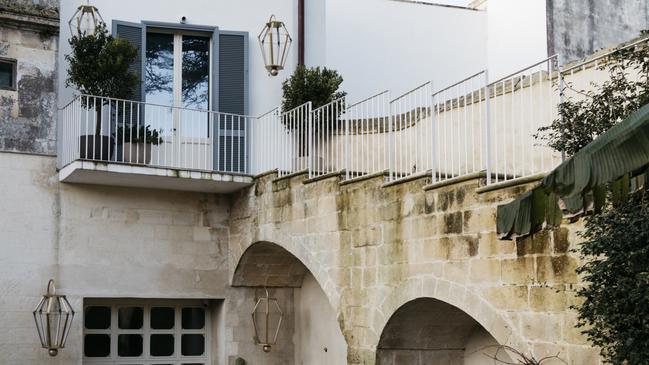
City of art, city of light: it’s safe to say that Lecce probably qualifies as both. The jewel in Puglia’s south, all extravagant palaces and church facades replete with wedding-cake details, wears the hot Mediterranean sun beautifully: its wide squares of pietra Leccese glow subtly at dawn, blaze creamy-white at midday, fade to delicate blush with the arrival of the ora di aperitivo.
Anna Maria Enselmi is no stranger to this beauty. A Milanese collector of important 20th century furniture and a contemporary-art enthusiast, she has long owned a house in Castro Marina, not far from the city. One day in 2016, at lunch with friends who knew all about her passion for real estate (almost equal, it turns out, to her passion for design), someone let slip about a place up for sale: a magnificent, if slightly run-down, palace with 16th century foundations, spread over almost an entire block on one of Lecce’s most important thoroughfares – its original east-west oriented roman decumanus – just a few hundred metres from the Duomo. Intrigued, Enselmi went for a viewing. “That day – and I recall perfectly, it was August 29 – it really was love at first sight. I was absolutely fascinated by it,” she told me of the Palazzo dei Conti di Lecce, which she purchased shortly thereafter.
It was the vastness of the palace, for one thing – the amplitude of spaces, from the soaring ceilings of the rooms on the piano nobile to the breadth of the attic, which gives onto a rambling, 300sq m terrace with sigh-provoking views of the city’s ancient roman amphitheatre. Another was the opportunity the palazzo presented, within the walls of a city that had emerged as a locus of sophisticated culture and hospitality. And then there was that light. “Between it and the space,” Enselmi says, “it struck me as the perfect place for the pieces I’d been collecting for so long” – most of which had been consigned for years to storage in a Milan warehouse.
The house was rechristened Palazzo Luce; and last May, after a long renovation, it quietly opened as a seven-suite private villa, available to let – a repository of world-class works of contemporary art and 20th century design, in dynamic dialogue with each other and the palazzo’s historic spaces.
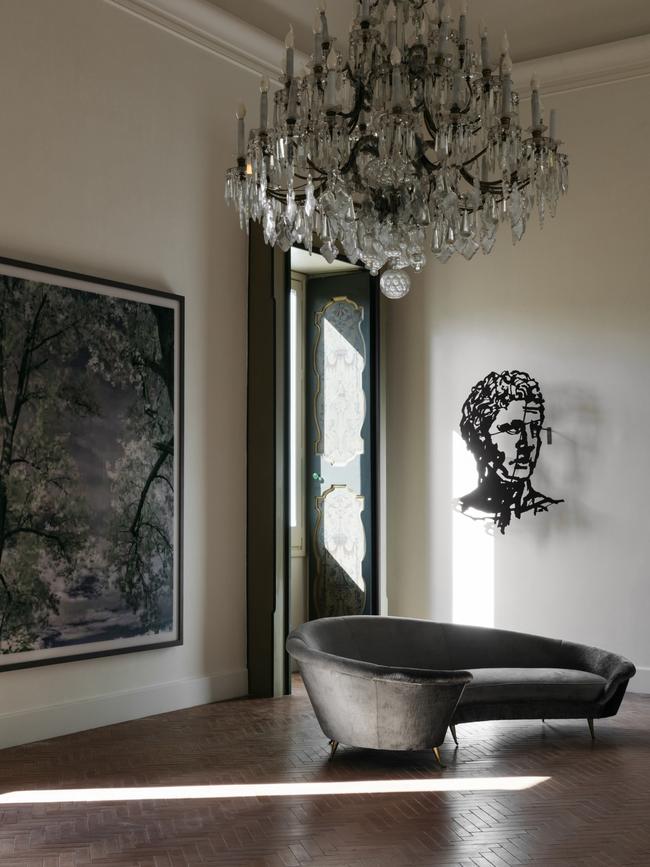
The four-year restoration project involved two architecture teams, scads of interior restorers, landscape designers, a famous designer of tents and pavilions, and one tiny but extremely commanding art dealer, who has become Enselmi’s trusted collaborator as well as a mentor of sorts. Lia Rumma, who has eponymous galleries in Naples and Milan, was a seminal figure in the global contemporary art scene throughout the latter 20th century; it is in great part thanks to her that Italian artists such as Michelangelo Pistoletto, Gino de Domenicis, and Alberto Burri achieved the critical renown they did in the ’70s and ’80s –and later, that the likes of Thomas Ruff, Andreas Gursky, Anselm Kiefer and Marina Abramovic rose to global fame.
“I felt strong and very competent on design,” says Enselmi, who for a decade and a half had collaborated with prominent furniture dealers, among them Nina Yashar (of Nilufar Gallery) and Rossella Colombari, and whose collection includes spectacular original pieces by Gio Ponti, Ettore Sotsass and Osvaldo Borsani, among others. “But contemporary art was still new to me. And there were a few links missing, and the project wanted to be coherent in every last detail.” Meeting Rumma, she says, was decisive. “She came, she visited the entire palazzo, every space; then told me to have a long think about which artists I saw in them, and why.” After a week, says Enselmi, she presented her list (she laughingly refers to it as her “homework”, a nod to Rumma’s formidable influence), and they set about their curation.
“There’s a genuine empathy there,” says Enselmi of the relationship, which has evolved into a sort of shared artistic directorship of the palazzo. “Watching her really consider the spaces, the relationships between the various works, and have her explain it all to me – I consider that a unique privilege. I’ve learned about the contemporary art market, but I’ve equally valued learning how very much goes into those interactions and dialogues. Nothing is anywhere just by chance, ever.”
Rumma was on site for part of my visit last spring, overseeing the hanging of monumental photographs by Thomas Ruff and the installation of a chromatic wall sculpture by Giuliano dal Molin in the Palazzo’s enormous main salotto – once, in another era, its music room. She led me on a brief tour; while I admired the handmade, Gio Ponti-inspired tile floors of the attic suites – commissioned by Giuliano Dell’Uva, one of Palazzo Luce’s principal architects—and a large-format photo titled Acqua Micans by Marzia Migliora, I asked Rumma about her process. She responded by quoting De Domenicis, the sometime enfant terrible who she helped make a star of post-war Italian art: “’It’s not I who decides or declares where each work belongs,’ is what he used to say,” she told me. “He [always] said: it’s the art that tells us.” Every work, she maintains, has a life of its own.
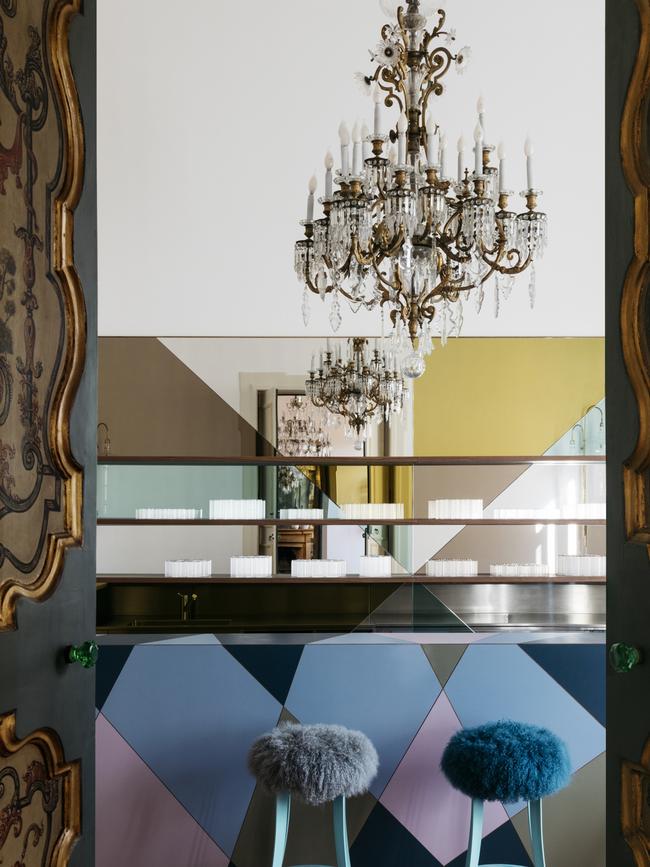
It follows, then, that to let the works (of design and art) speak for themselves while also creating room after room, space after space – indoor and outdoor – where the narrative is both formally coherent and sensually pleasing is no small feat. Walk along the endless corridors of the palazzo’s first floor, though, and you understand quickly that this is what Rumma and Enselmi have achieved. In that salotto grande, the sorbet pastels of a work from Ruff’s jpeg series are an ice-toned response to the warmer views of Lecce, visible through 3m-tall French doors painted soft green with gilt detailing. Four massive, laser-cut steel portraits by William Kentridge hang facing each other on opposing walls, while the sculpture by Dal Molin – groupings of long, painted wood staffs, mounted horizontally on a perpendicular wall – glow and fade in the changing light. In the adjacent library, sofas by the London-based Italian designer Martino Gamper and Brigitte Niedermair – better known for her fine-art photography – are arranged around a 1940s Seguso glass coffee table in front of a large 18th century marble fireplace.
Gio Ponti figures prominently across the project, not just in terms of Enselmi’s impressive inventory – original chairs, tables, cabinetry, even ceramic sinks and toilets – but also in terms of inspiration for the architect Dell’Uva, who reprised numerous “pontian” materials and colours (there is a delightful preponderance of bold blues and yellows), and who worked with the ceramic tile producers Ponti himself patronised in Salerno, south of Amalfi, to produce the attic suites’ stunning floors and the tiles of the rooftop pool.
Palazzo Luce’s other major collaborators, Milan-based architects Storage Associati, brought a similar rigour to several of the suites on the piano nobile. Strong colours—blue, purple, an aqueous green—and bold, sculptural shapes for the bespoke furniture, from headboards to free-standing screens to lighting, evince the meticulous attention Storage gave to how each piece would interact with Enselmi’s collection. (The spectacular spiral stair they designed to connect the first and second floors is arguably their piece de resistance; but the kitchen – at once impossibly sleek and entirely cosy, with its combination of vintage yellow tile and polished brass cabinetry and benches – brings equal wow factor.)
Throughout, the mix of materials and media is dynamic and provocative. There is the cement-and-iron Konstantin Grcic lamp, spotlighting a brilliantly simple white desk that was designed by Ponti in the ’30s for his daughter; behind them is a C-print from one of Vanessa Beecroft’s well-known performance series, VB52. On the roof terrace there is the surprise of neon glowing against crumbling brick – a work by the American conceptual artist Joseph Kosuth, hung on an exterior wall, newly-planted rose vines beginning to meander desultorily up either side of it. In the long corridor of the piano nobile a 2m-long ceramic installation by Antonio Marras (a one-time darling of the fashion world, latterly dedicating himself to fine art) undulates in horizonal waves of pale rose and apricot; clusters of his ceramic vases also adorn the fireplace mantle and tables in the library.
The things of which Enselmi is arguably proudest, however, are the palazzo’s handful of site-specific installations. Besides Dal Molin’s sculpture, a large fresco adorns the ceiling of one of the suites, commissioned by Dell’Uva from the English sculptor and muralist David Tremlett—an artist long associated with Puglia, thanks to his Wall Surfaces mural series on public buildings across Bari, the region’s commercial capital. And then there is Palazzo Luce’s knockout bar – a small room off of the salotto grande, reimagined entirely by Gamper. “I really went mad for [it],” Anselmi says of this bar. “Perhaps more than anyone else involved with the project, Martino truly interacted with Ponti and his legacy in this design,” which reprises Ponti’s bold palette and geometric themes with polished painted and finished metal panelling and cabinetry—generally, she says, “giving new contemporary life to [Ponti’s] work.”
Lest all this in its aggregate sound more museum than holiday villa, rest assured that Enselmi bore all the necessary creature comforts in mind as she progressed through her reimagining of the palazzo. Bathrooms are spacious, and most of them are suffused with natural light. Every suite has a sitting area; the two attic suites open directly onto the huge terrace, now planted with beds of roses and dotted with potted palms; its dining area is shaded by mobile canvas panels, striped in deep green and white, designed by Guido Roschi, the Turin-based creative director whose marquis, pavilions and valences decorate the gardens of tutta Italia bene.
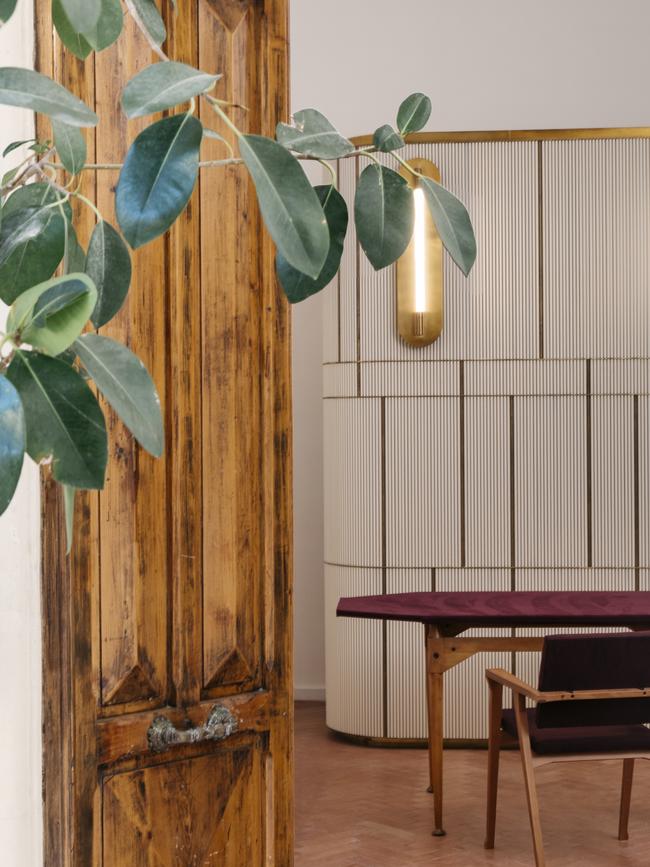
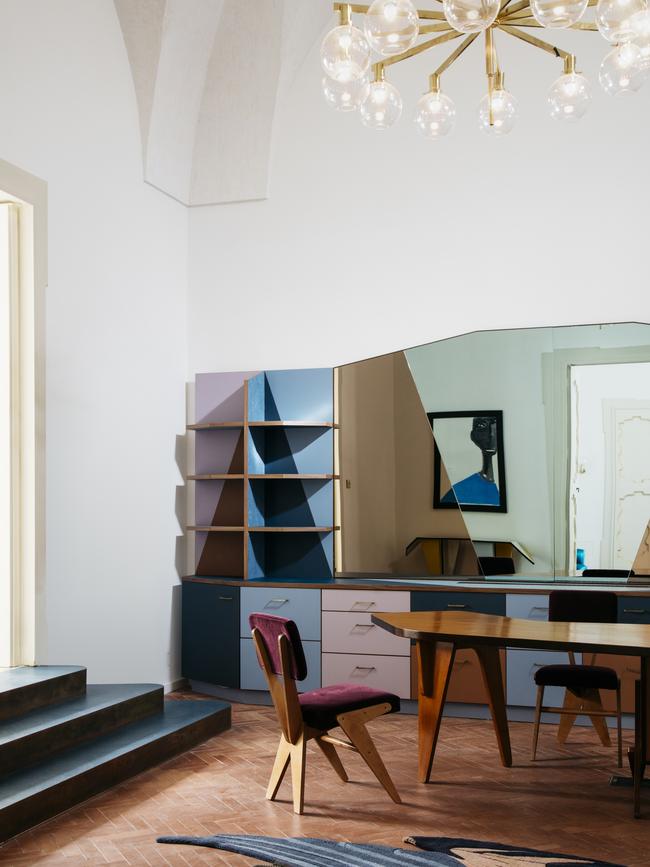
Across the corridor from the kitchen is a cosy breakfast room with its own fireplace; but in the kitchen itself, there’s a big, inviting marble table at which guests are more than welcome to breakfast, lunch or dine. From a terrace just off it, a tiled staircase meanders down in a loose spiral to a ground-level courtyard garden, planted with bougainvillea and banana trees. And from there a tall, arched glass door leads to a hammam, a “spa” zone – dim, cool, its low-slung sofas inviting a mid-afternoon idyll – and private pilates studio.
From the time she first saw it in 2016, Enselmi had an ambitious aesthetic vision for her palace of light; but she never lost sight of the fact that an important part of its story was always going to be the welcome it would offer to guests. Palazzo Luce reconciles aesthetic rigour and the warmth of genuine hospitality in a unique way—as compelling and inviting as the city at whose centre it sits, basking in the sun.
Palazzolucelecce.com; from €8,000 per night, exclusive use
Read more in WISH Magazine’s Italian Issue, out Friday
